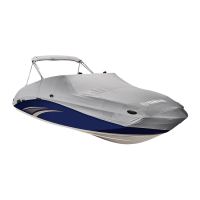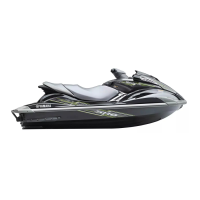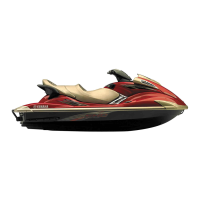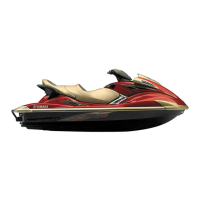Do you have a question about the Yamaha SX192 and is the answer not in the manual?
Information on how to record and keep track of primary and hull identification numbers.
Location and description of the Hull Identification Number stamped on the boat.
Location of the engine serial number label on the engine unit.
Details on emission control information conforming to U.S. EPA regulations for marine SI engines.
Location of approval labels for emission control certificates on the engine and compartment.
Location of the manufactured date label attached to the engine unit.
Visual guide to important labels found on the boat's dashboard and other locations.
Visual guide to important labels on the boat's exterior and interior components.
Detailed explanations of critical warning labels related to safety hazards and operating precautions.
Detailed explanations of warning labels concerning hazards like falling, fire, and internal injuries.
Detailed explanations of warning labels regarding hazards like falling, fuel leaks, and high-speed operation.
Guidelines on operator age, training requirements, and passenger limits for safe boat operation.
Safe operating practices including visibility, defensive driving, and avoiding collisions.
Requirements for personal flotation devices (PFDs), fire extinguishers, and distress signals.
Details on mandatory equipment like PFDs, fire extinguishers, and signaling devices as per USCG regulations.
Information on hazards related to enclosed areas, exhaust fumes, and carbon monoxide.
Safety precautions for operating the boat during nighttime, including lighting requirements.
Procedure for stopping the engine using the shut-off switch to prevent injury.
Explanation of boating rules and regulations, including right-of-way and vessel interactions.
Guidance on which vessel has the right-of-way in various navigation scenarios.
Procedures for encountering other vessels, including meeting, crossing, and overtaking.
Rules for crossing paths with other power-driven vessels to avoid collisions.
Guidelines for meeting other power-driven vessels head-on, emphasizing right-of-way.
Rules for overtaking another vessel safely, focusing on maintaining speed and direction.
How to interpret US buoyage systems, including shapes, colors, and numbers.
Detailed explanation of the US Aids to Navigation System (ATONS) and buoy meanings.
Diagram showing the location of major components on the AR192 model boat.
Diagram showing the location of major components on the SX192 model boat.
Diagram showing the location of more major components on the SX192 model boat.
Diagram and list of components located at the stern of the boat.
Diagram and list of components located at the helm (steering station) of the boat.
Instructions on how to operate the engine shut-off switch and its safety implications.
Safe operation guidelines for the remote control lever, including warnings about obstacles.
How the engine overheat warning system functions to protect the engine.
Warning and action for low engine oil pressure to prevent engine damage.
What to do when the 'Check Engine' warning appears, indicating a potential malfunction.
Safety warnings and instructions for collapsing and setting up the wakeboard tower.
Detailed steps for loosening knobs and lowering the wakeboard tower poles.
Detailed steps for lifting and securing the wakeboard tower.
Step-by-step instructions for setting up the Bimini top on the AR192 model.
Final steps for securing the Bimini top, including latching and tightening straps.
Step-by-step instructions for removing the Bimini top.
Instructions for correctly installing the Bimini top.
Step-by-step instructions for setting up the Bimini top on the SX192 model.
Final steps for securing the Bimini top on the SX192, including latching and tightening straps.
Instructions for removing the SX192 Bimini top.
Information on recommended fuel types, octane ratings, and fuel safety precautions.
Recommended engine oil types and grades for 4-stroke engines.
Step-by-step procedure for checking the engine oil level and condition.
Detailed steps for checking the engine oil level using the dipstick.
Essential steps and precautions for the engine break-in period to ensure proper performance.
Comprehensive checklist of pre-operation checks for steering, controls, and safety systems.
Detailed checks for steering system, remote control lever, and fire extinguisher.
Verifying the engine oil level is between the minimum and maximum marks.
Ensuring the engine shut-off cord (lanyard) is undamaged and properly attached.
Checking the engine shut-off switch for proper operation.
Step-by-step instructions for starting the boat engine safely.
Detailed steps for starting the engine, including safety precautions and warnings.
Sequence of operations for starting the engine, including using the main switch and remote control lever.
How to safely stop the boat engine and the procedures to follow.
Detailed steps for flushing the engine's cooling system to prevent clogging.
Instructions for preparing the fuel system for long-term storage to prevent issues.
A chart outlining periodic maintenance intervals and required services.
Procedures for replacing the engine oil and oil filter.
Safety precautions and procedures for recharging the boat battery.
Chart detailing possible causes and remedies for starter motor problems.
Chart detailing possible causes and remedies for engine warning, stalling, and speed issues.
Procedures to follow in emergency situations, such as jet pump clean-out.
Step-by-step guide to clean out the jet pump intake in case of clogging.
Further steps for emergency procedures, including access port cap and lock procedures.
Safety precautions and procedures for jump-starting the boat's engine.
Details of the limited warranty coverage for Yamaha boats.
Information on how to record and keep track of primary and hull identification numbers.
Location and description of the Hull Identification Number stamped on the boat.
Location of the engine serial number label on the engine unit.
Details on emission control information conforming to U.S. EPA regulations for marine SI engines.
Location of approval labels for emission control certificates on the engine and compartment.
Location of the manufactured date label attached to the engine unit.
Visual guide to important labels found on the boat's dashboard and other locations.
Visual guide to important labels on the boat's exterior and interior components.
Detailed explanations of critical warning labels related to safety hazards and operating precautions.
Detailed explanations of warning labels concerning hazards like falling, fire, and internal injuries.
Detailed explanations of warning labels regarding hazards like falling, fuel leaks, and high-speed operation.
Guidelines on operator age, training requirements, and passenger limits for safe boat operation.
Safe operating practices including visibility, defensive driving, and avoiding collisions.
Requirements for personal flotation devices (PFDs), fire extinguishers, and distress signals.
Details on mandatory equipment like PFDs, fire extinguishers, and signaling devices as per USCG regulations.
Information on hazards related to enclosed areas, exhaust fumes, and carbon monoxide.
Safety precautions for operating the boat during nighttime, including lighting requirements.
Procedure for stopping the engine using the shut-off switch to prevent injury.
Explanation of boating rules and regulations, including right-of-way and vessel interactions.
Guidance on which vessel has the right-of-way in various navigation scenarios.
Procedures for encountering other vessels, including meeting, crossing, and overtaking.
Rules for crossing paths with other power-driven vessels to avoid collisions.
Guidelines for meeting other power-driven vessels head-on, emphasizing right-of-way.
Rules for overtaking another vessel safely, focusing on maintaining speed and direction.
How to interpret US buoyage systems, including shapes, colors, and numbers.
Detailed explanation of the US Aids to Navigation System (ATONS) and buoy meanings.
Diagram showing the location of major components on the AR192 model boat.
Diagram showing the location of major components on the SX192 model boat.
Diagram showing the location of more major components on the SX192 model boat.
Diagram and list of components located at the stern of the boat.
Diagram and list of components located at the helm (steering station) of the boat.
Instructions on how to operate the engine shut-off switch and its safety implications.
Safe operation guidelines for the remote control lever, including warnings about obstacles.
How the engine overheat warning system functions to protect the engine.
Warning and action for low engine oil pressure to prevent engine damage.
What to do when the 'Check Engine' warning appears, indicating a potential malfunction.
Safety warnings and instructions for collapsing and setting up the wakeboard tower.
Detailed steps for loosening knobs and lowering the wakeboard tower poles.
Detailed steps for lifting and securing the wakeboard tower.
Step-by-step instructions for setting up the Bimini top on the AR192 model.
Final steps for securing the Bimini top, including latching and tightening straps.
Step-by-step instructions for removing the Bimini top.
Instructions for correctly installing the Bimini top.
Step-by-step instructions for setting up the Bimini top on the SX192 model.
Final steps for securing the Bimini top on the SX192, including latching and tightening straps.
Instructions for removing the SX192 Bimini top.
Information on recommended fuel types, octane ratings, and fuel safety precautions.
Recommended engine oil types and grades for 4-stroke engines.
Step-by-step procedure for checking the engine oil level and condition.
Detailed steps for checking the engine oil level using the dipstick.
Essential steps and precautions for the engine break-in period to ensure proper performance.
Comprehensive checklist of pre-operation checks for steering, controls, and safety systems.
Detailed checks for steering system, remote control lever, and fire extinguisher.
Verifying the engine oil level is between the minimum and maximum marks.
Ensuring the engine shut-off cord (lanyard) is undamaged and properly attached.
Checking the engine shut-off switch for proper operation.
Step-by-step instructions for starting the boat engine safely.
Detailed steps for starting the engine, including safety precautions and warnings.
Sequence of operations for starting the engine, including using the main switch and remote control lever.
How to safely stop the boat engine and the procedures to follow.
Detailed steps for flushing the engine's cooling system to prevent clogging.
Instructions for preparing the fuel system for long-term storage to prevent issues.
A chart outlining periodic maintenance intervals and required services.
Procedures for replacing the engine oil and oil filter.
Safety precautions and procedures for recharging the boat battery.
Chart detailing possible causes and remedies for starter motor problems.
Chart detailing possible causes and remedies for engine warning, stalling, and speed issues.
Procedures to follow in emergency situations, such as jet pump clean-out.
Step-by-step guide to clean out the jet pump intake in case of clogging.
Further steps for emergency procedures, including access port cap and lock procedures.
Safety precautions and procedures for jump-starting the boat's engine.
Details of the limited warranty coverage for Yamaha boats.











